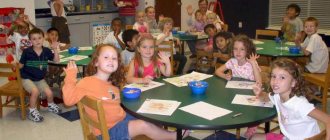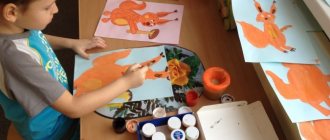Lesson notes on sensory development of young children
Natalia Artemyeva
Lesson notes on sensory development of young children
Organization: MBDOU "Kindergarten No. 363 Kamerton
Location: Nizhny Novgorod
Magnitude
BIG AND SMALL
Goal: To teach the child to alternate objects by size
Equipment: Five large and small beads (approximately 2 and 1 cm)
same color. Cord doll and basket.
Progress: The teacher shows the child a beautiful doll, says that the doll came to visit the baby and brought something in a basket. Then the teacher places the doll on the table and, taking the box out of the basket, shows the child that there are large and small beads and a cord there. Having said that the doll asked the child to make beautiful beads for her, the teacher draws the child’s attention to the fact that beads can be strung in different ways. First, the teacher himself shows how to collect the beads, and then asks the child to do it. It is better to start alternating with a large bead, because if you alternate beads the other way around (if you first take a small one, then a large one)
The child will find it difficult to complete the task because he is primarily attracted to large beads. Then the doll is shown how the beads turned out.
WHICH BALL IS BIGGER?
Goal: To learn to distinguish objects by size and select them according to verbal instructions.
Equipment: Large and small balls, randomly mixed.
Procedure: The teacher stands at a distance of 3 - 5 m from the child and asks to bring him a large ball. If the child makes a mistake, the teacher explains and shows the difference by giving the child to hold a large and a small ball. With the child’s hand, the teacher traces a large and small ball around the circumference, saying “big”
this or
“small”
ball. The game repeats itself.
ORDERS
Goal: To teach children to distinguish and name toys, as well as to identify their size; develop auditory perception , improve understanding of speech.
Equipment: Large and small bunnies, cars, boxes, balls, cups, cubes, matryoshka dolls.
Progress: The teacher shows the child toys and objects and asks him to name them, noting their size. Then he gives the child the following tasks:
Give the big bunny tea from a large cup, and the little bunny from a small one;
Ride the nesting doll in a big car;
Place a little bunny near the nesting doll;
Build a house from large cubes for the big bunny, and from small ones for the little one;
Collect small cubes in a small box, and large ones in a large one, etc.
If the child makes a mistake, the bunny or matryoshka shows his displeasure (sad or turns away)
.
Forms
WHAT SHAPE IS THIS?
Goal: To teach the child to alternate objects according to shape
Equipment: Four round and square clay beads of the same color (diameter 2cm)
. Cord or soft wire, doll and basket.
Progress: Played in the same way as the game “Big and Small”
the only difference is that round and square beads are alternately strung on the thread.
The teacher invites the child to touch each bead on the string with his hands, fixing the child’s attention on this and saying: “Ball, cube...”
.
CIRCLE, SQUARE
Goal: Learn to group objects by shape.
Equipment: Five cardboard circles and squares of the same color.
Progress: The teacher shows the children geometric shapes randomly mixed on the table. Then he says: “This is a circle, this is a square. I will put the circle on a round plate, and the square on a square plate.” Next, the teacher invites the children to put the figures in their places and activates the children’s speech with questions : “What is this? (Circle)
.
And this? (Square)
, etc.”
MAGIC BOX
Purpose: To teach children to push geometric shapes into the corresponding holes.
Equipment: Boxes with round and square holes and cubes and balls corresponding in size.
Progress: The teacher shows the children boxes with “windows”
and says that you can push balls and cubes into them.
Then he circles the round hole with his finger, noting that it is round and that it has no corners, and pushes the ball into it. He does the same with the square hole, noting that it is square and has corners, and pushes the cube into it. Next, the children complete the task. With each push, the teacher exclaims in a surprised and delighted tone: “Oh, there’s no ball!
Oh, no dice! , thereby stimulating the child to continue playing and causing positive emotions.
This game can also be used to fix the size of objects by making large and small holes in boxes of various uniform geometric shapes. You can add holes of other geometric shapes, for example, triangular, rectangular, etc.
MAT YOUR PANTS
Purpose: To teach children to insert objects of a given shape into the corresponding holes.
Equipment: Cardboard image of a bear (matryoshka dolls, dolls, etc.)
with round, square and triangular holes on the pants and, correspondingly, circles, squares and triangles, the same color as the pants.
Procedure: The teacher shows the children the bear and draws their attention to the fact that the bear has holes in its pants. Then the teacher shows the children geometric shapes - patches and offers to help the little bear mend his pants. The children complete the task, the little bear thanks them.
This game can be played with complications, for example - “darn”
The nesting dolls have sundresses of different colors in various large and small geometric shapes of corresponding colors.
LET'S TREAT THE BEAR WITH A BERRY
Goal: To teach children to choose objects of a given color from several offered, to develop hand coordination and fine motor skills of the fingers.
Equipment: A box with a mosaic containing ten red elements and five yellow and green elements each.
Progress: The teacher shows the bear to the children and examines it together with the children. Then he invites the children to treat him to a berry, emphasizing that the bear loves only ripe red berries. Next, the teacher takes a red mosaic element (a berry) from the box, inserts it into the panel and invites the children to pick berries too, making sure that the children take only ripe red berries. When all the red berries are collected in the “basket”
, the bear thanks
the children .
For the same purpose as the previous game, you can play the following games: “Find the sun”
,
“Plant some grass”
,
“Clouds in the sky”
, etc., with the only difference being that the child is asked to choose elements of yellow, green and blue, respectively, from several proposed ones.
Sensory development, education
Sensory education of children is a purposeful process during which, with the organization of correct pedagogical interaction, perception develops, the child’s sensory experience accumulates, and ideas about the world around him are formed. The result of sensory education is the sensory development of the child.
Development of sensory perception and the formation of sensory standards in children of primary and senior preschool age through games and exercises.
Sensory education is the development of a child’s abilities for sensory knowledge of the world: touch, hearing, vision, smell, sense of taste. Development of the sensory sphere of children of primary preschool age through didactic games.
Sensory education means improvement and development of sensory processes in children. System of sensory development of children of primary preschool age. The task of the kindergarten is to ensure the most complete development of pupils, taking into account age characteristics at the stage of completion of preschool education, to prepare them for school.
Sensory development of a child is the formation of a specific system for the development of sensory perception of the external properties of various objects - their shape, color, size, location in space, smell, taste, etc. There are five sensory systems with the help of which a person experiences the world: vision, hearing , touch, smell, taste. The site presents work experience, lesson notes on sensory development in the junior, middle, senior and preparatory groups.
The section of the site, sensory development, education in kindergarten for different age groups, contains many interesting activities for educators on various topics:
- Approximate planning of sensory games in the first junior group “Rainbow”
- Sensory development
- Thematic planning of play activities for children's sensory development
- Sensory education
- children's sensory development
- Classes on sensory education and speech development of children in the first junior group
- When should I start developing my child’s sensory skills?
- Sensory development of a child from birth to school
- Sensory education classes for young children
- When should I start developing my child’s sensory skills?
- The development of a child's sensory skills begins at birth
- Didactic games for sensory education of children
- Sensory education of children of senior preschool age
- Project on sensory development in the second junior group “Color Mosaic”
- Didactic sensory games for preschool children “Guess the taste”
- Development of sensory skills in the first junior group “Solar Circle” in accordance with the Federal State Educational Standard
- ECD for sensory development in kindergarten “Visiting Grandma Polina” junior group
- Sensory lesson in kindergarten “Colorful fish”
- Lesson on sensory development in kindergarten for children from 2 to 3 years old “Adventures in the forest”
- Lesson on sensory development of children in kindergarten “Dolls came to visit us” 1st junior group
It is recommended to help a preschooler get comfortable in this world and learn to use the reflexes and feelings inherent in nature from the first days of life. Development of sensory perception and the formation of sensory standards in children of primary and senior preschool age through games and exercises. .From the first seconds of birth, the baby immediately begins to interact with the world around him. For adults, this process is not noticeable, since it manifests itself in things that are familiar to us, but his senses collect information at an incredible speed.
Among the methods of early childhood development, the formation of sensory culture occupies a significant place. This is a gradual familiarization of the child with the diversity of the outside world by influencing his senses - vision, hearing, tactile sensations, smell and taste. What is the benefit of such development, at what age to start and can it be done at home? Read about this and other aspects of sensory integration on our website. Why is sensory development necessary?
The full sensory development of a child contributes to his successful education in kindergarten and school, is useful for many types of work activities, and ensures psycho-emotional well-being. At every age of a child, sensory education has its own goals.
Sensory development is an extremely important stage in the formation of children’s intelligence. Practical activities with young children will help take a big step in the harmonious development of the individual. Newborn babies come into this world with a basic set of abilities inherent in nature, one of which is knowledge of the environment through perception. Perception (or sensory) is extremely necessary for later life.




